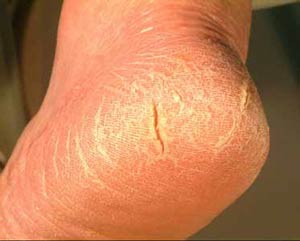Cracks in the skin at the back of the heel are common, are painful, and do not look very good. They happen when the fat pad beneath the heel expands out sideways beneath the foot and the dried-out skin cracks or splits to develop a heel fissure. A good way to fully understand these is to use the analogy of a tomato being compressed. As you apply pressure to the tomato to squash it, the skin of the tomato cracks as the content forces outwards. So it is with the heel. As bodyweight squashes the fat beneath the heel it stretches out sideways from underneath the heel, it tries to split the skin around the edges of the heel. If this is successful or not is going to depend on how supple and resilient that the epidermis is. If the skin is dry, thicker or callused, it is going to crack easily. If the skin is thicker with a layer of callus, that skin will split easily and put a strain on the healthy skin underneath that may become quite painful, sometimes bleeding. Every step that is taken with further open the crack which will help prevent it from healing. Cracked heels are more common in people who use open heel type footwear, as a closed in shoe will help keep the fat pad beneath the heel in place and help avoid or reduce the effects of the crack.

The most efficient short term treatment of cracked heels is to have the thick skin debrided by a podiatrist and then use strapping to hold the sides of the crack together so that it can heal. The long term prevention of cracked skin around the heel ought to be apparent from the process that was described above. To begin with, weight reduction will help reduce the problem, but this is a long term concern. To help stop the fat pad under the heel from expanding out laterally and trying to crack the skin, a closed in shoe needs to be used and frequently the use of deep heel cup insoles can help. A podiatric doctor ought to be consulted routinely to remove any dry callused skin. Emollients have to be used regularly to keep the skin supple so that it does not crack. The use of filing tools to help keep the thick skin under control could also be used.